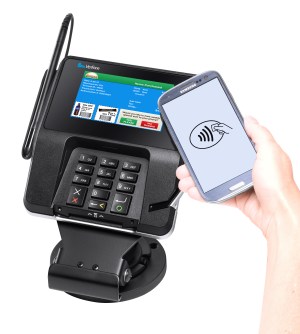A couple of days ago, I stopped into my little neighborhood market to pick up a paper, and I noticed a new credit card reader sitting on the counter. It looked a lot like the old one, but it had an Apple Pay symbol on it.
I asked Les (the proprietor) if it cost a lot to put in a new point-of-sale system. He answered that it didn’t cost anything. His credit card processor, he said, had provided the new hardware for free.
I found this interesting — I have expressed doubts in the past that small merchants would buy into Apple Pay because of the costs of putting in new gear, employee training, and interchange fees on every purchase. (See “Apple Pay: Big questions remain about what U.S. merchants get out of it“)
Well, that last one remains true, but the first two, it turns out, may not be barriers to merchants like Les accepting Apple Pay payments.
AI Weekly
The must-read newsletter for AI and Big Data industry written by Khari Johnson, Kyle Wiggers, and Seth Colaner.
Included with VentureBeat Insider and VentureBeat VIP memberships.
I talked to some people from Verifone, a large company that makes the NFC-enabled payment terminals used at the point-of-sale. The company manufactures and sells the terminals directly to very large, or “enterprise” retailers, and distributes them to small merchants through hundreds of partners including payment processors, acquirers and resellers—commonly referred to as ISOs (independent sales organizations).
Shan Ethridge, VP and general manager of Verifone’s North American Financial Group, says these ISOs often sell their own card processing services along with Verifone’s terminals, which the ISOs can use to provide a series of value-added services to merchants, such as customer loyalty program capabilities at the point-of-sale.
But, increasingly, merchants are viewing the ability to accept Apple Pay and other types of NFC-based payments as a value add in and of itself, Ethridge says. “Essentially, Apple Pay acceptance provides another ‘cool factor’ that ISOs can offer to help small merchants distinguish themselves from their competitors,” Ethridge told VentureBeat.
“Attrition is the biggest inhibitor of business for these resellers, so it’s not uncommon for them to give a retailer the terminal and then make their money on the processing and other value-added offerings,” Ethridge adds.
And then there’s EMV. As of Oct. 1, merchants are liable for fraud that takes place in point-of-sale systems that don’t support cards with new EMV chips inside. (EMV stands for “Europay, MasterCard and Visa.”) The new readers will accept a card insertion instead of the card swipe we’re used to. So it requires a new machine. And many merchants will want to convert to card readers that support both EMV and contactless payments via technology like Apple Pay.
With the new machines, the merchant still has to pay the 2 percent-to-3 percent interchange fee on each transaction (you’ll still see signs in some stores saying “Minimum card purchase $5). But they may not have to shell out for the point-of-sale terminals.
In the end, merchants don’t want to get in the way of people buying things by failing to support the latest payment methods. Right now, Ethridge points out, a certain cool factor surrounds Apple Pay, but that might evolve into a real behavior change among consumers. Being able to buy a newspaper and bagel with Apple Pay or Android Pay or Samsung Pay, or whatever, might become an expectation, not just a novelty.
VentureBeat's mission is to be a digital town square for technical decision-makers to gain knowledge about transformative enterprise technology and transact. Learn More

